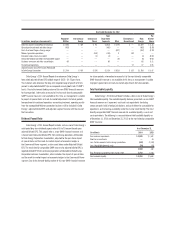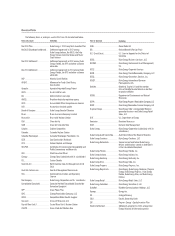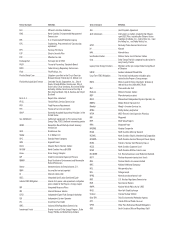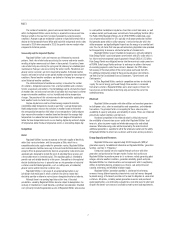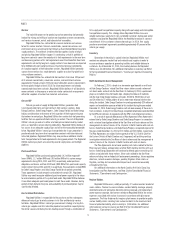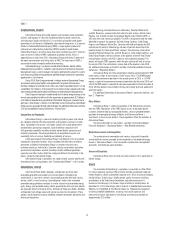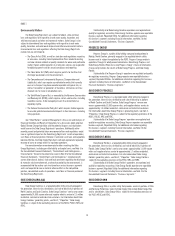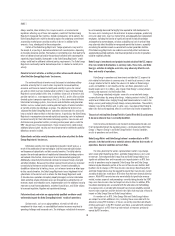Duke Energy 2014 Annual Report Download - page 29
Download and view the complete annual report
Please find page 29 of the 2014 Duke Energy annual report below. You can navigate through the pages in the report by either clicking on the pages listed below, or by using the keyword search tool below to find specific information within the annual report.
PART I
9
Nuclear
The industrial processes for producing nuclear generating fuel generally
involve the mining and milling of uranium ore to produce uranium concentrates,
and services to convert, enrich, and fabricate fuel assemblies.
Regulated Utilities has contracted for uranium materials and services
to fuel its nuclear reactors. Uranium concentrates, conversion services and
enrichment services are primarily met through a diversifi ed portfolio of long-term
supply contracts. The contracts are diversifi ed by supplier, country of origin
and pricing. Regulated Utilities staggers its contracting so that its portfolio of
long-term contracts covers the majority of its fuel requirements in the near term
and decreasing portions of its fuel requirements over time thereafter. Near-term
requirements not met by long-term supply contracts have been and are expected
to be fulfi lled with spot market purchases. Due to the technical complexities
of changing suppliers of fuel fabrication services, Regulated Utilities generally
sources these services to a single domestic supplier on a plant-by-plant basis
using multiyear contracts.
Regulated Utilities has entered into fuel contracts that cover 100 percent
of its uranium concentrates, conversion services, and enrichment services
requirements through at least 2015 and cover fabrication services requirements
for these plants through at least 2018. For future requirements not already
covered under long-term contracts, Regulated Utilities believes it will be able to
renew contracts as they expire, or enter into similar contractual arrangements
with other suppliers of nuclear fuel materials and services.
Gas and Oil
Natural gas and oil supply for Regulated Utilities’ generation fl eet
is purchased under term and spot contracts from various suppliers. Duke
Energy Carolinas, Duke Energy Progress, Duke Energy Florida and Duke Energy
Indiana use derivative instruments to limit a portion of their exposure to price
fl uctuations for natural gas. Regulated Utilities has certain dual-fuel generating
facilities that can operate with both natural gas and oil. The cost of Regulated
Utilities’ natural gas and oil is either at a fi xed price or determined by market
prices as reported in certain industry publications. Regulated Utilities believes it
has access to an adequate supply of gas and oil for the reasonably foreseeable
future. Regulated Utilities’ natural gas transportation for its gas generation is
purchased under long-term fi rm transportation contracts with interstate and
intrastate pipelines. Regulated Utilities may also purchase additional shorter-
term transportation for its load requirements during peak periods. The Regulated
Utilities natural gas plants are served by several supply zones and multiple
pipelines.
Purchased Power
Regulated Utilities purchased approximately 14.3 million megawatt-
hours (MWh), 11.7 million MWh and 19.8 million MWh of its system energy
requirements during 2014, 2013 and 2012, respectively, under purchase
obligations and leases and had 4,500 and 3,800 MW of fi rm purchased capacity
under contract during 2014 and 2013, respectively. These amounts include MWh
for Duke Energy Progress and Duke Energy Florida for all periods presented.
These agreements include amounts contracted with certain QFs. Regulated
Utilities may need to acquire additional purchased power capacity in the future
to accommodate a portion of its system load needs. Regulated Utilities believes
it can obtain adequate purchased power to meet these needs. However, during
periods of high demand, the price and availability of purchased power may be
signifi cantly affected.
Gas for Retail Distribution
Regulated Utilities is responsible for the purchase and the subsequent
delivery of natural gas to retail customers in its Ohio and Kentucky service
territories. Regulated Utilities’ natural gas procurement strategy is to buy fi rm
natural gas supplies and fi rm interstate pipeline transportation capacity during
the winter season and during the non-heating season through a combination of
fi rm supply and transportation capacity along with spot supply and interruptible
transportation capacity. This strategy allows Regulated Utilities to assure
reliable natural gas supply for its non-curtailable customers during peak winter
conditions and provides Regulated Utilities the fl exibility to reduce its contract
commitments if fi rm customers choose alternate gas. In 2014, fi rm supply
purchase commitment agreements provided approximately 97 percent of the
natural gas supply.
Inventory
Generation of electricity is capital intensive. Regulated Utilities must
maintain an adequate stock of fuel and materials and supplies in order to
ensure continuous operation of generating facilities and reliable delivery to
customers. As of December 31, 2014, the inventory balance for Regulated
Utilities was $3,348 million. For additional information on inventory see Note 1
to the Consolidated Financial Statements, “Summary of Signifi cant Accounting
Policies.”
North Carolina Ash Basin Management
On February 2, 2014, a break in a stormwater pipe beneath an ash basin
at Duke Energy Carolinas’ retired Dan River steam station caused a release of
ash basin water and ash into the Dan River. On February 8, 2014, a permanent
plug was installed in the stormwater pipe, stopping the release of materials
into the river. Duke Energy Carolinas estimates 30,000 to 39,000 tons of ash
and 24 million to 27 million gallons of basin water were released into the river
during the incident. Duke Energy Carolinas incurred approximately $24 million of
repairs and remediation expense related to this incident during the year ended
December 31, 2014. Duke Energy Carolinas will not seek recovery of these costs
from customers. In July 2014, Duke Energy completed remediation work identifi ed
by the EPA and continues to cooperate with the EPA’s civil enforcement process.
As a result of separate Memoranda of Plea Agreement (Plea Agreements)
entered into by Duke Energy Carolinas and Duke Energy Progress in connection
with a criminal investigation related to the Dan River ash basin release and the
management of coal ash basins at the 14 plants in North Carolina with coal ash
basins, Duke Energy Carolinas and Duke Energy Progress recognized expense for
the year ended December 31, 2014 of $72 million and $30 million, respectively.
The Plea Agreements are subject to the approval of the U.S. District Court for
the Eastern District of North Carolina and, if approved, will end the grand jury
investigation related to the Dan River ash basin release and the management of
coal ash basins at the 14 plants in North Carolina with coal ash basins.
The Plea Agreements do not cover pending civil claims related to the Dan
River coal ash release and operations at other North Carolina facilities with ash
basins. Duke Energy Corporation will continue to defend against remaining civil
actions associated with these matters. Other costs related to the Dan River
release including state or federal civil enforcement proceedings, future regulatory
directives, natural resources damages, pending litigation, future claims or
litigation, and long-term environmental impact costs cannot be reasonably
estimated at this time.
For additional information on the North Carolina Ash Basin Grand Jury
Investigation and Plea Agreements, see Note 5 to the Consolidated Financial
Statements, “Commitments and Contingencies.”
Nuclear Matters
Regulated Utilities owns, wholly or partially, 12 nuclear reactors located at
seven stations. Nuclear insurance includes: nuclear liability coverage; property,
decontamination and premature decommissioning coverage; and replacement
power expense coverage. Joint owners reimburse Regulated Utilities for certain
expenses associated with nuclear insurance in accordance with joint owner
agreements. The Price-Anderson Act requires plant owners to provide for public
nuclear liability claims resulting from nuclear incidents to the maximum total
fi nancial protection liability, which currently is $13.6 billion. For additional
information on nuclear insurance see Note 5 to the Consolidated Financial
Statements, “Commitments and Contingencies.”


